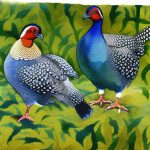Guinea fowl, also known as guineas, are native to the African continent and have been domesticated for centuries. They are popular for their unique appearance, hardiness, and ability to control pests such as ticks, flies, and other insects. In India, guinea fowl farming has gained popularity in recent years due to the increasing demand for organic meat and eggs. There are several guinea fowl breeds that are raised in India, each with its own unique characteristics and traits. These breeds are valued for their adaptability to different climates, disease resistance, and low maintenance requirements, making them an attractive option for small-scale farmers and homesteaders.
Key Takeaways
- Guinea fowl farming is gaining popularity in India due to its low maintenance and high-quality meat and eggs.
- Popular guinea fowl breeds in India include the Indian Guinea Fowl, Helmeted Guinea Fowl, and Lavender Guinea Fowl.
- Different guinea fowl breeds have varying characteristics and traits, such as coloration, size, and egg production.
- Breeding and rearing guinea fowl in India requires proper housing, feeding, and healthcare to ensure optimal growth and productivity.
- Guinea fowl farming practices in India involve free-range grazing, supplemented with a balanced diet and access to clean water.
Popular Guinea Fowl Breeds in India
In India, some of the popular guinea fowl breeds include the Helmeted Guinea Fowl, White Guinea Fowl, and Lavender Guinea Fowl. The Helmeted Guinea Fowl is the most common breed and is known for its distinctive appearance with a bony casque on top of its head. They are hardy birds that can adapt to a wide range of climates and are valued for their ability to forage for food and control pests. The White Guinea Fowl, as the name suggests, is characterized by its pure white plumage. They are prized for their ornamental value and are often kept for their aesthetic appeal. The Lavender Guinea Fowl, on the other hand, is known for its unique lavender-colored plumage, making it a sought-after breed for ornamental purposes. These breeds are all valued for their meat and eggs, making them a versatile option for farmers looking to diversify their poultry operations.
Characteristics and Traits of Different Guinea Fowl Breeds
Each guinea fowl breed has its own unique characteristics and traits that make them suitable for different purposes. The Helmeted Guinea Fowl is known for its hardiness, adaptability, and excellent pest control abilities. They are also valued for their meat and eggs, making them a popular choice for farmers looking to raise guineas for both consumption and pest control. The White Guinea Fowl, with its pure white plumage, is often kept for ornamental purposes and is prized for its aesthetic appeal. While they may not be as prolific in terms of egg production as other breeds, they are valued for their unique appearance and calm disposition. The Lavender Guinea Fowl, with its striking lavender-colored plumage, is also kept for ornamental purposes and is often sought after by hobbyists and collectors. They are known for their gentle nature and are valued for their beauty and uniqueness.
Breeding and Rearing Guinea Fowl in India
Breeding and rearing guinea fowl in India requires careful planning and management to ensure the health and productivity of the birds. When it comes to breeding guinea fowl, it is important to provide them with a suitable environment that mimics their natural habitat. This includes access to open spaces for foraging, dust bathing areas, and secure housing to protect them from predators. Guinea fowl are known for their strong flock instincts, so it is important to provide them with ample space to roam and socialize. When it comes to rearing guinea fowl chicks, it is important to provide them with a warm and secure brooding area with access to heat lamps and proper nutrition. It is also important to provide them with access to fresh water and a balanced diet to ensure their healthy growth and development.
Guinea Fowl Farming Practices in India
Guinea fowl farming in India involves a range of practices aimed at ensuring the health and productivity of the birds. One of the key practices in guinea fowl farming is providing them with a balanced diet that meets their nutritional needs. This includes a mix of commercial poultry feed, grains, greens, and insects to mimic their natural diet. It is also important to provide them with access to fresh water at all times to ensure their hydration and overall health. Another important practice in guinea fowl farming is providing them with a suitable housing environment that protects them from predators and the elements. This includes secure coops or shelters that provide them with ample space to roost and nest, as well as access to outdoor areas for foraging and exercise.
Challenges and Opportunities in Guinea Fowl Farming in India

While guinea fowl farming in India offers several opportunities, there are also challenges that farmers may face when raising these birds. One of the challenges in guinea fowl farming is predation, as guineas are vulnerable to attacks from predators such as foxes, dogs, and birds of prey. Farmers must take measures to secure their housing and outdoor areas to protect them from potential threats. Another challenge in guinea fowl farming is disease management, as guineas can be susceptible to certain poultry diseases such as respiratory infections and parasites. Farmers must implement biosecurity measures and regular health checks to prevent the spread of diseases within their flock. Despite these challenges, guinea fowl farming in India offers opportunities for small-scale farmers to diversify their poultry operations and meet the growing demand for organic meat and eggs.
Conclusion and Future Prospects for Guinea Fowl Breeds in India
In conclusion, guinea fowl farming in India offers several benefits including pest control, organic meat and eggs production, and ornamental value. With careful breeding and rearing practices, farmers can raise healthy and productive guinea fowl that contribute to sustainable agriculture practices. As the demand for organic products continues to grow in India, there are opportunities for farmers to capitalize on the unique qualities of guinea fowl breeds. By addressing challenges such as predation and disease management, farmers can build successful guinea fowl farming operations that contribute to the overall diversity of poultry farming in India. With proper management and investment in breeding programs, the future prospects for guinea fowl breeds in India look promising as they continue to gain popularity among farmers and consumers alike.
If you’re interested in learning more about poultry farming, you might also want to check out an article on how to care for goslings on PoultryWizard. This informative piece provides valuable insights into the breeding and care of geese, which can be a valuable addition to your poultry farm. You can find the article here.
FAQs
What are the different guinea fowl breeds in India?
There are several guinea fowl breeds found in India, including the Helmeted Guinea Fowl, the Crested Guinea Fowl, and the Vulturine Guinea Fowl.
What is the most common guinea fowl breed in India?
The Helmeted Guinea Fowl is the most common breed of guinea fowl found in India. It is known for its distinctive helmet-like casque on top of its head.
Are guinea fowl breeds in India suitable for domestication?
Yes, guinea fowl breeds in India are suitable for domestication. They are often kept for their pest control abilities and for their meat and eggs.
What are the characteristics of guinea fowl breeds in India?
Guinea fowl breeds in India are known for their hardiness, adaptability to various climates, and their ability to forage for insects and pests. They are also valued for their unique calls and colorful plumage.
What are the uses of guinea fowl breeds in India?
Guinea fowl breeds in India are used for pest control, as their diet consists mainly of insects and pests. They are also raised for their meat, which is considered lean and flavorful, and for their eggs, which are similar in taste to chicken eggs.
Meet Walter, the feathered-friend fanatic of Florida! Nestled in the sunshine state, Walter struts through life with his feathered companions, clucking his way to happiness. With a coop that’s fancier than a five-star hotel, he’s the Don Juan of the chicken world. When he’s not teaching his hens to do the cha-cha, you’ll find him in a heated debate with his prized rooster, Sir Clucks-a-Lot. Walter’s poultry passion is no yolk; he’s the sunny-side-up guy you never knew you needed in your flock of friends!







